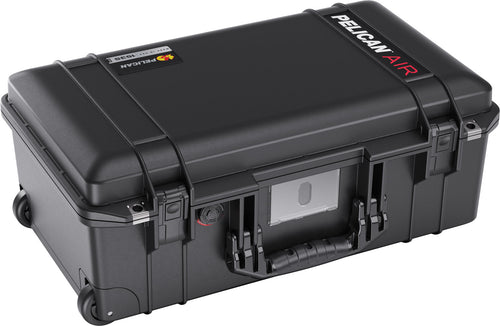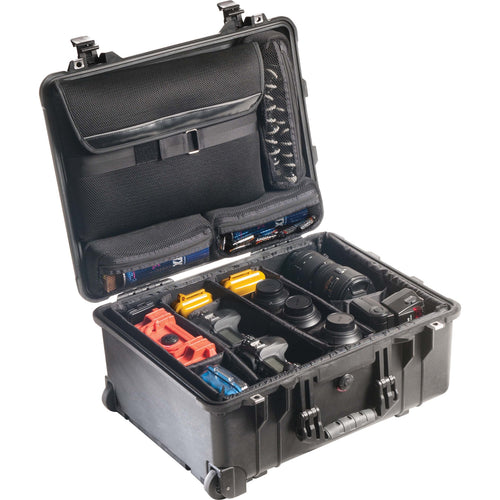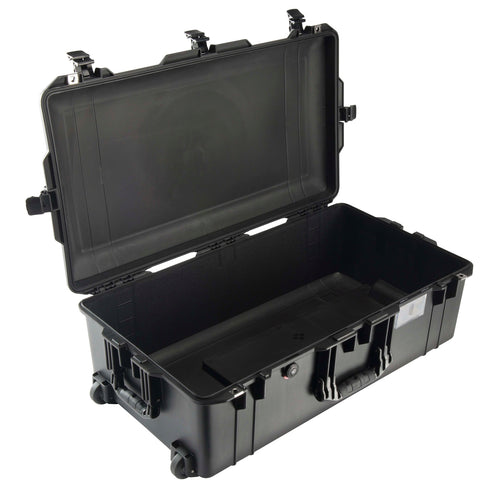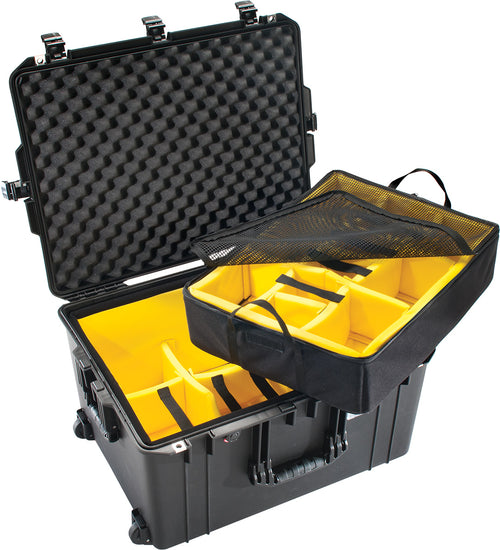
Just the thought of having to pay to replace your camera gear is enough to make most photographers very nervous!
Good camera gear costs money, and you don’t want to risk losing it. That’s why you want to make sure you protect your investment when you’re on the road.
But which Nikon and Canon camera case is the best? The real answer is that it depends on where you’re going and what kind of photography you’ll be doing once you get there.
There are a lot of considerations to balance when choosing a case, like cost, toughness/durability, and the big one: weight. For most photographers, the challenge is getting the gear to the shoot. If it’s in town and you’ve got a car, there are options available to you that you may not have if you’re flying somewhere or have to carry your gear up a mountain.
This article will help you weigh all the pros and cons and choose the right case for your needs.
We’ll even include some alternatives from other manufacturers whenever it makes sense.
Want to skip to the winning cases? Use these links:
Before You Start: Plan Your Shoot Down to the Last Cable
Sooner or later, all photographers learn that planning is critical - often the hard way.
It’s even more important when you’re buying cases, however, because you need to make sure that all your lenses, speedlights or strobes, power packs, stands, and light modifiers will fit.
And don’t forget all the smaller items you’ll need, like spare batteries, portable hard drives, and even your laptop (if you’re doing remote captures or starting on editing while at your destination).
Once you list out everything you’ll need, you can use a sheet of graph paper to determine the overall space requirements. This is important if you’re getting a case with pluck foam, that can only be set up once.
If you decide to go this route, don’t forget to allow space for padding between all the items. The last thing you want is damage to your best lenses because they got knocked together.
Pro tip: if the gear in the case will vary for every shoot, get padded dividers. They’re easy to rearrange in the case to keep gear protected.
Additional Considerations
Here are some additional things to think about to help you make decisions about which case to get:
- How critical is the shoot? If the project is essential to your career, you may want to take extra bodies and lenses in case something breaks. This is especially important in rural/wilderness areas with no camera stores around. If you’re doing a fashion shoot on a beach in the middle of nowhere, for example, you won’t have a chance to replace broken equipment.
- Will you be near or on the water? If so a waterproof case is a smart move, and so is knowing that it will float, and how many pounds/kilos the case can carry and still stay afloat if dropped overboard. In general, the larger the case, the more weight it can contain and still stay buoyant.
- Will you be doing a lot of walking with the case? If so scrutinize wheels and handles, or consider a backpack. Some wheels are great on smooth surfaces, but not so great on asphalt and other rough surfaces.
- For stands and lighting gear, do you need a separate case? Some come in their own cases already, but the quality of these varies considerably.
- How sunny/hot is the location? In a desert, a colour other than black may help keep gear cooler. While black is our most popular colour, there are other options, like tan, olive, and silver for many cases.
Best Carry On Case for Camera Gear
If your gear is too valuable to check, its case will need to fit within the maximum carry on size for airlines. We have a few suggestions that fit within the limits, but still give you the most amount of space possible.
1. The Pelican 1510
This is our hands-down best seller, and for good reason. It fits a standard gear setup (2 bodies, 2 reasonably long lenses, plus a speedlight and accessories).
It’s also waterproof, dustproof, and crushproof. It has wheels and a retractable handle. The Pelican 1510LOC version has a padded pouch for your laptop. There are all kinds of configurations, from empty through different foam options.
The cases itself weighs 13.6 lbs (6.1 kg) with foam, and will float with a total weight of up to 64.1 lbs (29.1 kg)
Which version of the 1510 should I get?
Pelican 1510 Protector Carry-On Case
Pelican 1510M Protector Mobility Case
Pelican 1510LFC Protector Laptop Case
Pelican 1510SC Protector Studio Case
2. The Pelican Air 1535
The Pelican Air 1535 has about the same dimensions as the 1510, but it’s 3.62 lbs (1.64 kg) lighter. If you’re doing a lot of walking, over time the weight difference can provide some serious relief.
It’s just as crushproof, dustproof, and water tight as the 1510, but is slightly more expensive. The 1535 also has lots of choices in how the interior is configured.
View the Pelican 1535 Air Carry-On Case
The Best Camera Backpack - Carry On
S130 Sport Elite Laptop / Camera Divider Pack
This is our top selling backpack because of its versatility and comfort. It also meets airline carry-on size requirements.
There's a built-in top loading waterproof/dustproof hard case for your laptop (designed for the Ultrabook™ but fits most laptops up to 15"). It comes with insertable pads to keep smaller laptops from moving around. The laptop compartment is lockable.
The main part of the backpack can hold up to 25 L in total, so it has plenty of room for bodies, lenses, and additional cases. The removable camera compartment is protected from bumps by a hard panel on the outside of the backpack, while the inside is configurable with padded dividers.
There are tons of straps and buckles you can use to compress the bag, adjust it for the perfect fit for carrying, or to attach stands. Side pouches will fit your water bottle or smaller collapsible tripods.
To help you on long walks, the ergonomic lumbar and shoulder straps are nicely padded, and there's a ventilated pack panel to help cool your back on warm days.
Backpack vs Hard Case: Which is Right for Me?
With a backpack, you ditch the weight of a case but gain better portability and comfort. If you’re doing a lot of walking over irregular ground, the ergonomic supports and straps of the S130 will save your lower back. For hiking, a backpack is definitely your best bet.
A backpack designed for cameras and laptops will maintain a respectable level of protection against bumps and rain. But if seriously dramatic drops or total immersion in water are a concern, get a case. Cases are more buoyant if they get dropped in the water.
Bonus: hard cases can be surprisingly handy on location: they double as tables for changing lenses, seats, or steps. Yes, with a Pelican case, a person can stand on it.
Security: some areas of the world are known for pickpockets. While the S130 is made of tough fabric and the pockets are protected by covers, no backpack will be as secure as a case. If you’re concerned, get a hard case. They’re completely lockable and require some determined knife work and a lot of time to open.
Portability hack: you can always put a hard case like the 1510 in a regular backpack if you just want to strap it on and go, or disguise it from thieves. This won’t necessarily work with the larger cases, though, if they’re loaded with gear.
Pro tip: The Pelican 0350 is a line of Mobility cases that are designed to accommodate a set of full-swivel casters.
The Best Cases for Larger Shoots
If a case is larger than carry on size, you’ll need to check it if you’re flying. That means it’s got to stand up to be thrown around by baggage handlers.
The need for durability doesn’t end there. Once you’re at your destination, your case may get thrown on the top of a jeep for a trip down a dirt road, strapped to a yak, or piled up on the deck of a ferry.
In short, you may want to consider allowing even more room for padding inside the case than you would with a carry on. The trade off, of course, is the logistics for how many cases are you prepared to lug around.
Before you purchase your case, confirm the dimensions and weight limit for checked baggage for your airline. For most North American airlines, it’s currently (as of 2018) a total of 62 inches. That means the length + width + height must be no greater than 62 inches (158 cm), with a 50 lb (23 kilo) weight limit. Exceptions may exist, so if you don’t want to pay an extra fee make sure you know for sure.
Here are some top options.
The Pelican 1560
Compared to the 1510, the 1560 is an extra 4 inches wide and 2 inches deep. It has all of the other great features of the 1510, including the corner wheels and retractable pull handle. Considering all the extra room you’ll get, it’s not much heavier at 20 lbs (9.07 kg) with foam.
There are lots of great configurations available, including the laptop overnight case (LOC) version that has a padded pouch for your laptop in the lid.
Which version of the 1560 should I get?
Pelican 1560SC Protector Studio Case
Pelican 1560M Protector Mobility Case
Pelican 1560LFC Protector Laptop Case
The Pelican Air 1615
If you’re looking for a little more room than a carry on size will allow, but you’re trying to keep the weight as low as possible, the Pelican 1615 may be the right answer. At 17 lbs (7.9 kg) with foam, the case offers an extra 10 inches in length, 4 inches in width, and 2 inches in height.
Just like the 1510, the 1615 is a wheeled case with a retractable pull handle.
Which version of the 1615 should I get?
Pelican 1615TRVL AIR Travel Case
The Pelican 1650
The Pelican 1650 case is the favourite case of cinematographer Daniel Green who has travelled around the world for his projects.
The 1650 offers almost 10 inches of additional length, 6.5 inches of additional width, and 3 inches of height on the interior. The case itself weighs 28.06 lbs (12.7 kg) and stays buoyant at up to 181 lbs (82 kg) of total weight. The wheels and retractable handle help ensure the case is easy to move around. There are additional handles on other sides of the case as well.
View detailed specs for the Pelican 1650 >
The Pelican Air 1637
This is a much deeper case, that will allow for two layers of equipment for most photographers. As a Pelican Air case made with Pelican's exclusive HPX2 polymer, it's much lighter than other cases of a comparable size.
When compared to the 1510, this case will give you 4 extra inches in length, 6.5 inches of extra width, and almost 6 inches of extra depth.
View detailed specs for the Pelican 1637 >
Still Have Questions?
We’re here to help. Let us know what you’re looking for and we’ll help you make a decision. Best of all, if the case isn’t quite right you can return it within 30 days (as long as it’s still in mint condition and in the original packaging).









